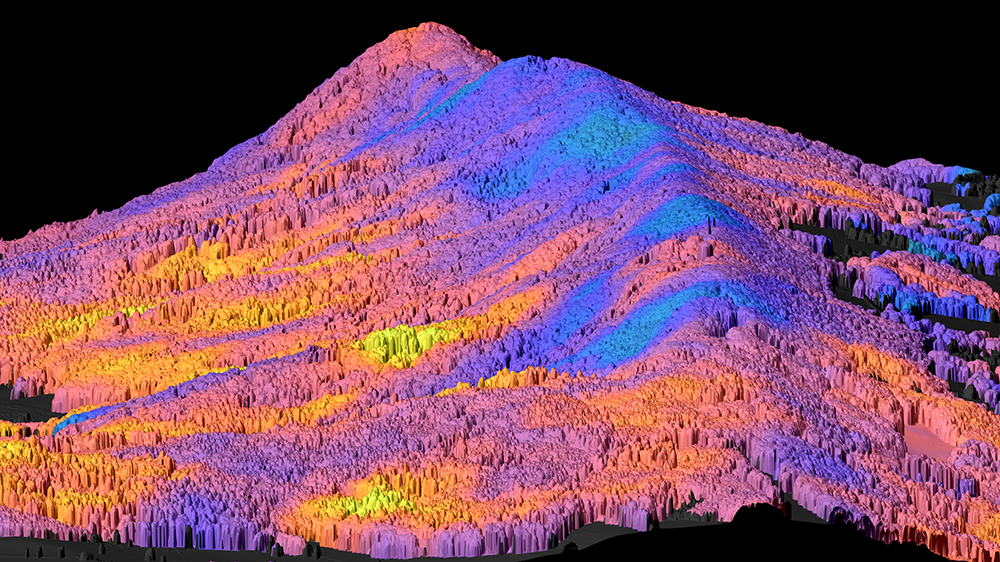Navigation auf uzh.ch
Navigation auf uzh.ch

Ecological studies have demonstrated positive relationships between plant diversity and ecosystem functioning. Forests with higher functional diversity are generally more productive and stable over long timescales than less diverse forests. Diverse plant communities show increased resource use efficiency and utilization, enhanced ecosystem productivity and stability and can better cope with changing environmental conditions – an insurance effect of biodiversity. They are also less vulnerable to diseases, insect attacks, fire and storms.
Plant functional diversity can directly be measured by mapping selected morphological and physiological traits of a forest from above. In the past, functional traits of plants had to be measured by very labor-intensive fieldwork on the ground. This fieldwork was either limited to very few measurable traits on larger plots or many traits on very small plots or single trees. Researchers from the UZH and the California Institute of Technology / NASA Jet Propulsion Laboratory have now developed a new remote-sensing method to map functional diversity of forests from small to large scales, independent of any predefined vegetation units or species information and without the need for ground-based calibration.
The research team applied their methods on the Laegern mountain, a temperate mixed forest ecosystem located near Zurich, Switzerland. "With remote sensing, we have the unique opportunity to study whole forest ecosystems by continuously mapping their functional traits looking from above on the leaves of the forest canopy over very large areas," says Michael Schaepman from the Remote Sensing Laboratories of the Department of Geography.
With airborne laser scanning, the scientists measured morphological characteristics of the forest canopy such as canopy height, foliage and branch densities. These measurements indicate how the sunlight is taken up by the canopy to assimilate carbon dioxide from the air and use the carbon to grow. In a canopy with a more diverse structure, light can better spread between different vertical canopy layers and among individual tree crowns, allowing for a more efficient capture of light. The researchers also characterized the forest with regards to its biochemical properties using airborne imaging spectroscopy. By measuring how leaves reflect the light in many spectral bands, they were able to derive physiological traits such as the content of leaf pigments (chlorophylls, carotenoids) and leaf water content. "These physiological traits provide information about the activity and health status of the trees. We can see, for example, if a tree is suffering water stress, and what resource allocation strategy a tree is following or how it adapts to the environment," Schaepman adds.
The researchers validated their method by comparing the results with leaf-level field measurements, species-level plot inventory data and databases providing functional trait values. Using computer modelling, they were able to assess diversity patterns of morphological and physiological traits at a whole range of scales, from local diversity between individual trees to large-scale patterns of plant communities following environmental gradients. The team found a strong relationship between the observed functional diversity patterns and environmental factors such as soil and topography, with lower diversity on the mountain ridge under harsher environmental conditions, where the trees adapted to the dry, steep, shallow and rocky soils.
"With remote sensing, we are now able to measure and monitor the diversity of forests, allowing us to observe changes at large scales and providing spatial information for nature conservation and climate change mitigation strategies," Michael Schaepman emphasizes. Since the methodology is only limited by the availability of advanced technological sensors, this work paves the way for future airborne and satellite missions aiming at monitoring global plant functional diversity from space.
Fabian D. Schneider, Felix Morsdorf, Bernhard Schmid, Owen L. Petchey, Andreas Hueni, David S. Schimel, Michael E. Schaepman. Mapping functional diversity from remotely sensed morphological and physiological forest traits. Nature Communications. 13 November 2017. DOI: 10.1038/s41467-017-01530-3